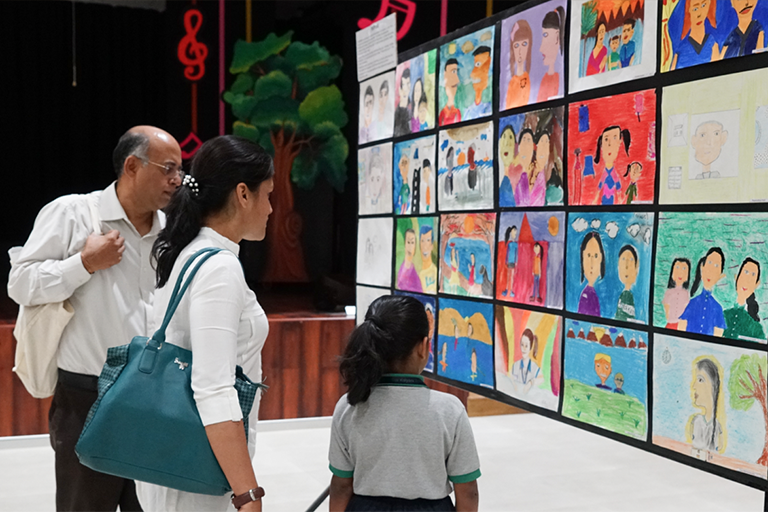

The Art Education Program or the AEP is our flagship programme that introduces art-integrated learning to educators and students, moulding environments the Art1st Way to building classrooms of the future. In the last decade, we have collaborated with private, public and community schools with independently-developed curriculum for Preschool, Primary and Middle school level.


Schools
collaborated with

Workshops
conducted

Educators
trained

Artist-mentors
coached

Children
impacted
At its nucleus is an active mentoring model – the AEP Teachers’ Training Program – that empowers educators with tools that enable exploration of new ways of teaching and learning – which they can take to the classrooms. It uses art-inspired creative thinking and inquiry-led approach as catalysts for opening dialogue and engaging with the child’s innate capacity to think creatively.
In all our collaborations, art integrated learning has dramatically shifted the way both learning and art are viewed. With the AEP, classrooms are converted into spaces where learning becomes a by-product of play, and diversity of views, voices and outcomes is celebrated.

Each artist-mentor from Art1st works closely with the teachers and the school management, delivering customised, hands-on training suited to their specific needs and challenges. This personalised approach enables the educators to identify their strengths and develop unique teaching methodologies.





At the end of each year, a curated exhibition of students’ artworks is creatively displayed in and around the school, encouraging students to appreciate and explore their own work as well as the work done by others. It invites the young artists’ parents and families, and at times even the neighbourhood community, to be an audience to the world from a child’s perspective.
The curatorial process is an immersive experience for the teachers themselves, as they’re guided to assess artworks in view of particular themes, and conceptualise inviting display areas to make thinking visible.
Art integrated learning implies learning through the lens of art – where art helps in exploring and learning of different subjects from the school curriculum as well as life at large. AIL is based on the premise that art is inseparable from history, science and all other streams of knowledge, and integrates larger knowledge building.
With its interdisciplinary approach, art integration cultivates critical and creative thinking in students. It opens possibilities for teachers to develop playful methods of teaching different and complex subjects, and also enables them to see the relevance of arts beyond its creative aspects.
The creative, activity-based approach of AIL enables students to grasp complex subjects and concepts with ease, relatability and active engagement.
Art1st Teachers’ Training Program helps the educators to explore various art-teaching approaches and tools, expand their knowledge about the world of art, and develop their own unique methodologies.
The AEP has helped students develop their visual literacy, creative expression, critical appreciation and unique artistic styles, as well as provided a foundation of habit-building for collective working and engaging closely with the society.
Designed with the help of leading educators and pedagogues, the Art1st books serve as provocations to enable creative and critical thinking skills in students.
An integrated, reflective way of teaching art aims at a habit building of the mind. It enables students to not only explore and experiment with different mediums, but to also gain exposure to different kinds of art and nurture their own unique styles. In comparison, skills in art only develop mimetic abilities in children and obstruct independent thinking.
Art1st books offer a systematically developed art curriculum and focus on a holistic knowledge building for children. They are founded on thorough research that is translated into storytelling and interactive engagements within the pages through games and play. They encourage and enable students to analyse, synthesise and interpret the world through various concepts of art and design, art theory, visual and non-visual tools of learning; opening up various affective methods of learning visual arts.
‘Craft’ comes under the larger umbrella of art. So, yes, Art1st books have multifarious craft exercises that enable children to appreciate, ideate and create.
Art appreciation in Art1st books is introduced in a playful manner via art projects and activities which helps children relate to them. This early exposure to art movements and artists opens up a space of limitless possibilities for the young minds. The idea is not for the students to memorise facts but to gain exposure and encouragement to think freely.
AEP shifts the teaching methodology in classrooms from instructions to probing questions; allowing students to think for themselves. The children are not seen as minds to be moulded but idea-banks to be unleashed, with teachers as their ‘companions in learning’. For any activity, it would be ideal to let children arrive at their own answers through dialogue and discussions, instead of giving them water-tight instructions.
Focussing only on ‘neatness’ or ‘colouring within the outlines’ is a very limiting approach to art. It discourages exploration and play that is very critical for allowing young minds to cultivate creative and independent thought.
Art1st uses methods of collective learning. Children find their own ways of holding a pencil or a brush and also learn from each other when they interact in a creative atmosphere. There is no right or wrong.
The AEP has a huge positive impact on a child’s growth. It allows children to retain their creative thinking, and find their own unique personalities. The dialogue-based classes instil respect for multiplicity of views and ways. The interdisciplinary approach makes them sensitive and observant towards the world, life and arrive at real-life solutions with a greater understanding and empathy.
All Rights Reserved 2023. Concept & Design by sixofusdesign.com
